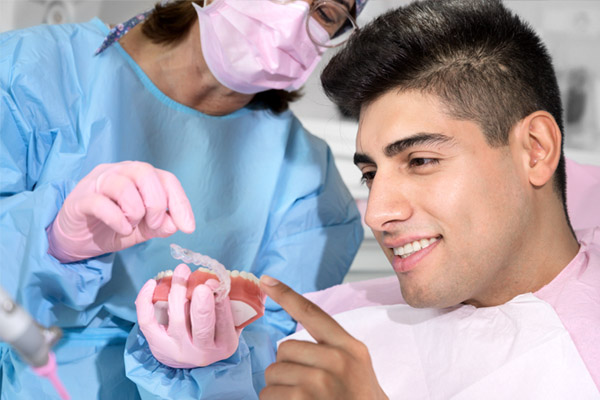 Invisalign® for teens can offer adolescents a more comfortable and more discreet option for straightening their teeth. For years, braces were one of the only options for effectively treating a crooked smile. Even though Invisalign® has been providing an alternative for decades, some people may not be familiar with who it is for and how it works.
Invisalign® for teens can offer adolescents a more comfortable and more discreet option for straightening their teeth. For years, braces were one of the only options for effectively treating a crooked smile. Even though Invisalign® has been providing an alternative for decades, some people may not be familiar with who it is for and how it works.
Common myths about Invisalign® treatment
Understanding the facts about using clear aligner trays can help patients determine which approach is right for their unique needs. Talk with a dentist about any questions you have so you can develop a proper treatment plan.
Myth: Only adults can use Invisalign®
Originally, when Invisalign® was first developed, it was only offered to adults who wanted straighter teeth without braces. However, advances in technology, products, and design have allowed this company to expand its patient range, including options for teenagers and even children with alignment issues. In fact, Invisalign® for teens has continued to increase in popularity over the past few years.
Myth: Invisalign® treatment is faster than using regular braces
How long your treatment lasts depends on a variety of factors:
- Age
- Overall oral health
- The extent of alignment issues
- Compliance with wearing the trays
- Ability to maintain regular appointments
In some cases, Invisalign® treatment may be faster than wearing braces. In others, it will take roughly the same amount of time. Patients who do not wear the trays for long enough periods may find their treatment takes longer than it would with braces. Only a dentist can give you an accurate time window for the expected duration.
While the overall time may not differ much, many patients find that when choosing Invisalign® for teens, they notice visible results much faster. This can be a confidence booster for many people and helps encourage continued proper use and care.
Myth: Invisalign® for teens is only effective for minor tooth alignment issues
While clear aligner trays can effectively address minor gaps or slightly crooked teeth, they can also treat more serious issues, including overbites and underbites, crossbites, larger gaps, and even open bites. However, you need to have a professional evaluation with a dentist to determine whether Invisalign® for teens can improve your unique smile. Some more serious cases may require braces or at least some type of dental work before treatment.
Myth: Invisalign® trays only have to be worn at night
Although clear aligner trays are completely removable, they should still be worn most of the time. Dentists recommend wearing them for a minimum of 22 hours every single day with no exceptions. For most people, this leaves just enough time to remove them for eating and toothbrushing and not much else. Retainers, which will be issued after treatment is complete, may need to be worn for longer periods at first, but they can eventually be worn only at night.
Conclusion
If you have assumptions about whether or not Invisalign® for teens can work for you or your child, talk with your dentist today. You may be surprised to find that it is a good option for straightening your smile.
Request an appointment or call Desert Sun Dental at 509-785-6491 for an appointment in our Quincy office.
Related Posts
If your teenager is in need of teeth straightening treatment, you may be wondering whether Invisalign® for teens is a viable option. There are pros and cons to everything in life, and Invisalign is no different. Here are four things to think about as you consider the appropriate choice for your child.Invisalign uses clear aligners…
Misaligned teeth are not just an aesthetic issue; they can lead to numerous problems, including oral pain, speech, and digestive issues, and increased tooth decay and gum disease. Invisalign® for teens is very effective in straightening teeth for improved confidence and better oral health. This type of treatment also offers unique perks that traditional braces…
Invisalign® for teens refers to the clear plastic device worn to straighten teeth as an alternative to metal braces. Many people opt to wear these types of devices when they are in their teenage years, but they can be worn by adults as well. Invisalign has the added benefits of being removable and less noticeable…
